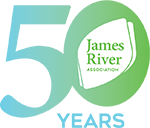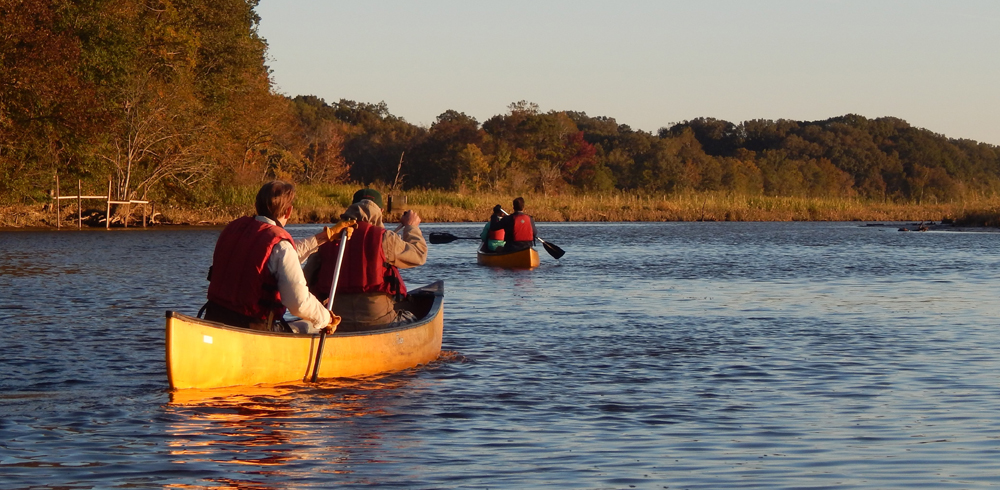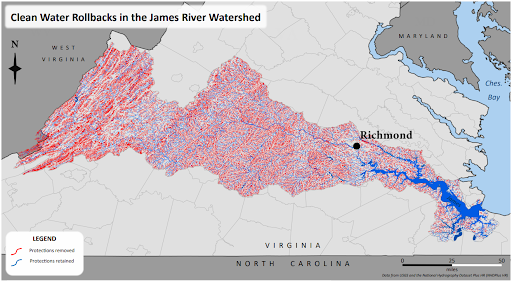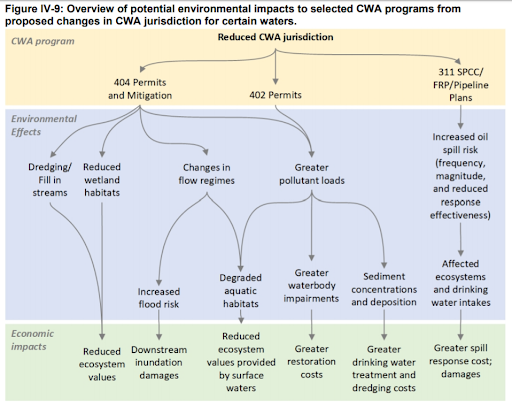What does the Dirty Water Rule mean for the James River?
(TL;DR – It’s bad news.)
Last month, the Environmental Protection Agency (EPA) announced troubling changes to the Clean Water Act (CWA), one of our Nation’s bedrock environmental laws that has protected the health of Americans and our waterways since 1972. Under the new Dirty Water Rule, the Agency is proposing to exclude thousands of miles of headwater streams and millions of acres of wetlands from federal protections.
This is an about-face from EPA’s previous policy, and it places roughly 65% of the James River’s stream miles at risk. Three out of every four Virginians rely on healthy headwaters for clean drinking water, including 2.7 million in the James watershed. Land disturbance, construction or discharge of wastewater are a few examples of activities that would normally be regulated and require careful planning and permitting to minimize impacts to water quality. If these vulnerable streams lose federal protections, it hurts our ability to prevent bad actors upstream from polluting drinking water downstream.
A strong CWA is not just environmentally necessary, it’s economically sound. Clean water and healthy wetlands promote active, resilient communities across our state and support local jobs and thriving industries worth billions in annual values.
At JRA, we’ve learned that with something as complex as restoring a river, we need everyone to take action for clean water. So we’ve asked everyone — Republicans and Democrats, farmers and city planners, school groups and homeowners — to pitch in on reducing pollution. We believe that a healthy James can power vibrant, thriving communities across Virginia, and we believe EPA’s current proposal is a major step away from that goal. But you can help us fight back:
- Raise your Voice – Tell EPA you oppose the Dirty Water Rule
- Raise Awareness – Learn more by exploring this interactive map of potential Dirty Water Rule impacts
Headwater Streams
Rivers and streams are typically divided into three groups: rain-dependent, seasonal, and perennial. Rain-dependent streams flow in response to recent precipitation; seasonal streams typically flow during wetter or cooler months of the year; and perennial streams flow year-round, except during periods of intense drought.
Under EPA’s new rule, rain-dependent and seasonal streams are directly at risk of losing federal protection, but that doesn’t mean that perennial systems like the James River will escape unharmed. The health of the James – or any major river – is inextricably linked to the health of its tributaries. You cannot protect a major river unless you protect the creeks and streams that flow into it. These systems are just too physically, chemically, and ecologically connected.
It’s estimated that the smallest headwater streams collectively contribute 70% of the water volume and 65% of the nitrogen pollution found in larger downstream waterways. Too much nitrogen is one of the largest hurdles separating us from a fully recovered James River, and it often comes from the end of an industrial wastewater pipe. We rely on the CWA to help regulate wastewater outfalls and ensure that industrial discharge is treated before it reaches our at-risk waterways. Figure 1 shows how some regulated outfalls release wastewater into streams that could lose protection under EPA’s rollback — possibly jeopardizing the management and oversight of these pollution sources.
Figure 1.
At-risk streams are shown in red, and permanent streams are shown in blue. Red dots display permitted pollution sources – many of which are located on at-risk streams. (Data from DEQ and USGS)
But our waterways aren’t just channels for industrial pollution – they’re also habitat highways for organisms. Headwater streams provide a host of ecological benefits to entire watersheds, upstream and down. They serve as critical refuges for species seeking shelter from high flows, from hot summer temperatures, and from native and invasive predators – stressors that are all predicted to become more intense in a warming world. In the James River watershed, our at-risk tributaries are home to species like brook trout – Virginia’s state fish and a favorite among anglers – responsible for bringing significant tourism revenue to many rural Virginia communities.
What does this mean for the James?
The health of the James River depends on the health of its tributaries. There are more than 25,000 miles of rivers and streams in the James River watershed that provide clean drinking water to 2.7 million Virginians and critical refuge for trophy species like brook trout. Of these, 16,500 miles, or a full 65%, are considered rain-dependent or seasonal and could lose their federal protection (Figure 2). This would significantly increase the threats of nutrient pollution from industrial sources – pollution that stands between us and a fully recovered James River.

Wetlands
Wetlands comprise some of Virginia’s richest and most biodiverse habitats, but they’re also among the most sensitive. From filtering water, to managing floods, to providing habitat for economically valuable and endangered species alike, wetlands are vital systems because of the critical environmental services they provide. This array of benefits is so extensive that its value is hard to quantify – so hard, in fact, that the EPA ignored them completely in the economic justification for their decision, despite decades of existing research into this topic. But more on this glaring omission later.
The US is losing wetlands at an alarming and unsustainable rate because of land use change and sea level rise – and EPA’s proposed redefinition would make things worse. Under the new rule, wetlands without a surface connection to other waters would lose protection, despite the ecological benefits they still provide to nearby waterways.
Wetlands of all kinds are better and less expensive methods of cleaning water and mitigating flooding than hardened infrastructure. A recent study found that every dollar invested in risk-reducing wetland construction achieves $8.72 in benefits. And yet despite this rate of return, EPA proposes to weaken wetlands’ protection, overlook their benefits, and marginalize coastal residents who rely on these systems to reduce flooding exposure.
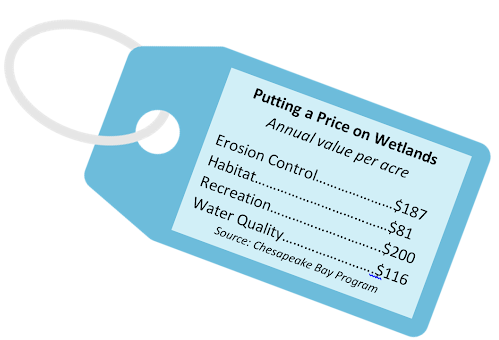
The annual value generated by an acre of intact wetlands – figures that were intentionally left out of EPA’s analysis.
What does this mean for the James?
In our watershed, the highest concentrations of at-risk wetlands are in the Tidewater region. Coastal Virginia has the most to gain if the ecological and economic value of these habitats is recognized – and the most to lose if they’re overlooked. Accelerating sea level rise is a growing threat for these communities, and the cities of southeast Virginia are already preparing. Many localities have begun major efforts to boost their resilience to rising seas, including Hampton and Norfolk, and wetlands are an indispensable part of the solution.
Economic Impacts
Healthy streams, habitats, and wildlife are major drivers for our strong outdoor economy. In Virginia, outdoor recreation is a billion dollar business — $21.9 billion to be more precise. That’s how much Virginia’s outdoor industry generates in consumer spending each year, supporting 197,000 direct jobs and $1.7 billion in state and local tax revenue. Clean water is also critical to another Virginia industry: craft beer. Ask any local brewer and you’ll learn that good beer starts with clean water. The Commonwealth is home to 190 craft breweries, 13th most in the Nation, with an annual economic impact of $1.37 billion. Virginia’s 312 wineries, 312 across the state, add another $1.37 billion.
Clearly, clean water pays dividends to communities in our state and across the country, which is why, in 2015, EPA estimated that a stronger CWA would deliver up to $500 million in benefits from wetlands protection alone. Those benefits far outweighed the costs for industrial polluters to manage their wastewater. But when the new administration proposed to rollback CWA protections and exclude more than half of our Nation’s wetlands from coverage, EPA needed to show that the rollback would be worth it.
How did the agency justify $500 million in lost benefits? It simply excluded them from their economic analysis. By claiming that studies on wetlands benefits conducted before 2000 were too old to consider, and then ignoring at least 10 studies published since 2000, EPA called the lost benefits “unquantifiable” and left them at $0. But it doesn’t take a dollar sign to see that the losses under this rollback will be profound. EPA’s own economic analysis describes the environmental and economic impact in Figure 3.
What does this mean for the James?
A healthy river is a valuable river. Today, the James River generates $18.9 billion in economic benefits annually. In 2016, 6.5 million pounds of fish and shellfish were commercially landed, with a dockside value of $18 million. More than 4 million people visited the parks located on the banks of the James and its tributary rivers and streams, enjoying more than 200 public access sites. And 230,000 people purchased hunting and fishing licenses within the James watershed. But according to our State of the James report, our river is at a score of B-. A fully restored river under the Chesapeake Bay cleanup plan could be worth over $22 billion, and we need strong regulatory protections like the CWA to help us get there.
What Can You Do?
- Raise your Voice – Tell EPA you oppose the Dirty Water Rule
- Raise Awareness – Learn more by exploring this interactive map of potential Dirty Water Rule impacts
